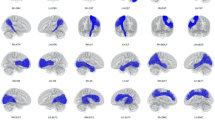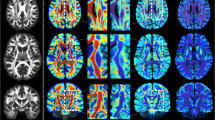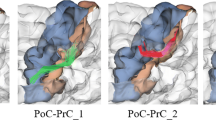Abstract
Fiber tracking is the most popular technique for creating white matter connectivity maps from diffusion tensor imaging (DTI). This approach requires a seeding process which is challenging because it is not clear how and where the seeds have to be placed. On the other hand, to enhance the interpretation of fiber maps, segmentation and clustering techniques are applied to organize fibers into anatomical structures. In this paper, we propose a new approach to automatically obtain bundles of fibers grouped into anatomical regions. This method applies an information-theoretic split-and-merge algorithm that considers fractional anisotropy and fiber orientation information to automatically segment white matter into volumes of interest (VOIs) of similar FA and eigenvector orientation. For each VOI, a number of planes and seeds is automatically placed in order to create the fiber bundles. The proposed approach avoids the need for the user to define seeding or selection regions. The whole process requires less than a minute and minimal user interaction. The agreement between the automated and manual approaches has been measured for 10 tracts in a DTI brain atlas and found to be almost perfect (kappa > 0.8) and substantial (kappa > 0.6). This method has also been evaluated on real DTI data considering 5 tracts. Agreement was substantial (kappa > 0.6) in most of the cases.










Similar content being viewed by others
References
Alexander, A. L., Hasan, K. M., Kindlmann, G. L., Parker, D. L., & Tsuruda, J. S. (2000). A geometric analysis of diffusion tensor measurements of the human brain. Magnetic Resonance in Medicine, 44(2), 283–291.
Ashburner, J. (2007). SPM5 manual. Functional Imaging Laboratory, Wellcome Trust Centre for Neuroimaging.
Basser, P. J., Pajevic, S., Pierpaoli, C., Duda, J., & Aldroubi, A. (2000). In vivo fiber tractography using DT-MRI data. Magnetic Resonance in Medicine, 44(4), 625–632.
Basser, P. J., & Pierpaoli, C. (1996). Microstructural and physiological features of tissues elucidated by quantitative-diffusion-tensor MRI. Journal of Magnetic Resonance Series B, 111(3), 209–219.
Bernal, B., & Altman, N. (2010). The connectivity of the superior longitudinal fasciculus: A tractography DTI study. Magnetic Resonance Imaging, 28(2), 217–25.
Brun, A., Björnemo, M., Kikinis, R., & Westin, C. F. (2004). Clustering fiber tracts using normalized cuts. In International conference on medical image computing and computer-assisted intervention (MICCAI’04). Lecture notes in computer science (pp. 368–375). Saint Malo: Rennes.
Cardenes, R., Munoz-Moreno, E., Sarabia-Herrero, R., Rodriguez-Velasco, M., Fuertes-Alija, J. J., & Martin-Fernandez, M. (2010). Analysis of the pyramidal tract in tumor patients using diffusion tensor imaging. NeuroImage, 50(1), 27–39.
Catani, M., Howard, R. J., Pajevic, S., & Jones, D. K. (2002). Virtual in vivo interactive dissection of white matter fasciculi in the human brain. NeuroImage, 17, 77–79.
Cohen-Adad, J., Benali, H., Hoge, R. D., & Rossignol, S. (2008). In vivo DTI of the healthy and injured cat spinal cord at high spatial and angular resolution. NeuroImage, 40(2), 685–97
Conturo, T. E., Lori, N. F., Cull, T. S., Akbudak, E., Snyder, A. Z., Shimony, J. S., et al. (1999). Tracking neuronal fiber pathways in the living human brain. Magnetic Resonance in Medicine, 35, 399–412.
Corouge, I., Gouttard, S., & Gerig, G. (2004). Towards a shape model of white matter fiber bundles using diffusion tensor MRI. In IEEE 2004 international symposium on biomedical imaging (ISBI 2004) (pp. 344–347).
Cover, T. M., & Thomas, J. A. (1991). Elements of information theory. New York: Wiley.
Gillard, J., Waldman, A., & Baker, P. (2005). Clinical MR neuroimaging: Diffusion, perfusion and spectroscopy. Cambridge: Cambridge University Press.
Hahn, K., Prigarin, S., & Pütz, B. (2001). Edge preserving regularization and tracking for diffusion tensor imaging. In International conference on medical image computing and computer assisted intervention (MICCAI’01) (pp. 195–203). Lecture notes in computer science 2208
Hahn, K., Prigarin, S., & Pütz, B. (2003). Spatial smoothing for diffusion tensor imaging with low signal to noise ratios. Discussion Paper 358, SFB 386, 2003, Ludwig-Maximilians-Universität München.
Holodny, A., Gor, D. M., Watts, R., Gutin, P. H., & Ulu, A. M. (2005). Diffusion-tensor MR tractography of somatotopic organization of corticospinal tracts in the internal capsule: Initial anatomic results in contradistinction to prior reports. Radiology, 234(3), 649–653.
Jianu, R., Demiralp, C., & Laidlaw, D. H. (2009). Exploring 3D DTI fiber tracts with linked 2D representations. IEEE Transactions on Visualization and Computer Graphics, 15(6), 1449–1456.
Johansen-Berg, H., & Behrens, T. E. J. (2009). Diffusion MRI: From quantitative measurement to in-vivo neuroanatomy. Academic Press.
Jonasson, L., Hagmann, P., Thiran, J. P., & Wedeen, V. J. (2005). Fiber tracts of high angular resolution diffusion MRI are easily segmented with spectral clustering. International Society for Magnetic Resonance in Medicine, 24(9), 1127–1137.
Jones, D. K., & Cercignani, M. (2010). Twenty-five pitfalls in the analysis of diffusion MRI data. NMR in Biomedicine, 23(7), 803–820.
Landis, J. R., & Koch, G. G. (1977). The measurement of observer agreement for categorical data. Biometrics, 33(1), 159–174.
Lazar, M., Weinstein, D. M., Tsuruda, J. S., Hasan, K. M., Arfanakis, K., Meyerand, M. E., et al. (2003). White matter tractography using diffusion tensor deflection. Human Brain Mapping, 18(4), 306–321.
Le Bihan, D., Mangin, J. F., Poupon, C., Clark, C. A., Pappata, S., Molko, N., & Chabriat, H. (2001) Diffusion tensor imaging: Concepts and applications. Journal of Magnetic Resonance Imaging, 13(4), 534–546.
Li, H., Xue, Z., Guo, L., Liu, T., Hunter, J., & Wong, S. T. C. (2010). A hybrid approach to automatic clustering of white matter fibers. NeuroImage, 49(2), 1249–1258.
Maddah, M., Mewes, A., Haker, S., Grimson, W. E. L., & Warfield, S. (2005). Automated atlas-based clustering of white matter fiber tracts from DTMRI. In International conference on medical image computing and computer assisted intervention, (MICCAI’05), Lecture notes in computer science (p. 188).
Masutani, Y., Aoki, S., Abe, O., & Ohtomo, K. (2006). Model-based tractography based on statistical atlas of MR-DTI. In 3rd IEEE international symposium on biomedical imaging: Macro to nano (pp. 89–92).
Mori, S., Wakana, S., Nagae-Poetscher, L. M., & Zijl, P. C. M. V. (2004). MRI atlas of human white matter. Amsterdam: Elsiever.
Mori, S., & Zijl, P. C. M. V. (2002). Fiber tracking: Principles and strategies—A technical review. NMR in Biomedicine, 15(7–8), 468–480.
Nöth, U., Meadows, G. E., Kotajima, F., Deichmann, R., Corfield, D. R., & Turner, R. (2006). Cerebral vascular response to hypercapnia: Determination with perfusion MRI at 1.5 and 3.0 Tesla using a pulsed arterial spin labeling technique. Journal of Magnetic Resonance Imaging: JMRI, 24(6), 1229–1235.
Nucifora, P. G. P., Verma, R., Lee, S.-k., & Melhem, E. R. (2007). Diffusion-tensor MR imaging and tractography: Exploring brain microstructure and connectivity. Radiology, 245(2), 367–384.
O’Donnell, L. J. (2006). Cerebral white matter analysis using diffusion imaging. Ph.D. thesis, MIT.
O’Donnell, L. J., & Westin, C. F. (2007). Automatic tractography segmentation using a highdimensional white matter atlas. IEEE Transactions on Medical Imaging, 11(26), 1562–1575.
O’Donnell, L. J., Westin, C. F., & Golby, A. J. (2009). Tract-based morphometry for white matter group analysis. Neuroimage, 3(45), 832–844.
Partridge, S. C., Mukherjee, P., Henry, R. G., Miller, S. P., Berman, J. I., Jin, H., et al. (2004). Diffusion tensor imaging: Serial quantification of white matter tract maturity in premature newborns. NeuroImage, 22(3), 1302–1314.
Pierpaoli, C., & Basser, P. J. (1996). Toward a quantitative assessment of diffusion. Magnetic Resonance in Medicine, 36(6), 893–906.
Prados, F., Boada, I., Feixas, M., Prats-Galino, A., Blasco, G., Pedraza, S., et al. (2007). DTIWeb: A web-based framework for DTI data visualization and processing. Lecture Notes in Computer Science, 4706/2007, 727–740.
Prados, F., Boada, I., Prats-Galino, A., Martín-Fernández, J. A., Feixas, M., Blasco, G., et al. (2010). Analysis of new diffusion tensor imaging anisotropy measures in the three-phase plot. Journal of Magnetic Resonance Imaging, 31(6), 1435–1444.
Rigau, J., Feixas, M., & Sbert, M. (2004). An information theoretic framework for image segmentation. In IEEE international conference on image processing (pp. 1193–1196).
Rollins, N. K. (2007). Clinical applications of diffusion tensor imaging and tractography in children. Pediatric Radiology, 37(8), 769–780.
Template Graphics Software Inc. (2002). Amira 3.1. Mercury Computer Systems.
Ulug, A. M., & van Zijl, P. C. (1999). Orientation-independent diffusion imaging without tensor diagonalization: Anisotropy definitions based on physical attributes of the diffusion ellipsoid. Magnetic Resonance Imaging, 9(6), 804–813.
Wakana, S., Jiang, H., Nagae-Poetscher, L. M., Zijl, P. C. M. V., & Mori, S. (2004). Fiber tract-based atlas of human white matter anatomy. Radiology, 1(230), 77–87.
Westin, C. F., Maier, S. E., Mamata, H., Nabavi, A., Jolesz, F. A., & Kikinis, R. (2002). Processing and visualization of diffusion tensor MRI. Medical Image Analysis, 6(2), 93–108.
Westin, C. F., Peled, S., Gudbjartsson, H., Kikinis, R., & Jolesz, F. A. (1997). Geometrical diffusion measures for MRI from tensor basis analysis. In ISMRM ’97 (p. 1742). Vancouver, Canada.
Xia, Y., Turken, U., Whitfield-Gabrieli, S. L., & Gabrieli, J. D. (2005). Knowledge-based classification of neuronal fibers in entire brain. In International conference on medical image computing and computer assisted intervention (MICCAI’05) (pp. 205–212).
Xu, D., Mori, S., Solaiyappan, M., van Zijl, P. C. M., & Davatzikos, C. (2002). A framework for callosal fiber distribution analysis. NeuroImage, 17, 1131–1143.
Zhang, S., & Laidlaw, D. H. (2002). Hierarchical clustering of streamtubes. Technical Report CS-02-18, Brown University Computer Science Department.
Zhang, W., Olivi, A., Hertig, S. J., van Zijl, P., & Mori, S. (2008). Automated fiber tracking of human brain white matter using diffusion tensor imaging. NeuroImage, 42(2), 771–777.
Zhang, Y., Zhang, J., Oishi, K., Faria, A. V., Jiang, H., Li, X., et al. (2010). Atlas-guided tract reconstruction for automated and comprehensive examination of the white matter anatomy. NeuroImage, 52(4), 1289–1301.
Acknowledgements
This work has been supported by TIN2010-21089-C03-01 and 2009 SGR 643 and FIS PS09/00596 of I+D+I 2009-2012.
Author information
Authors and Affiliations
Corresponding author
Appendix: 2D Image Partitioning Algorithm
Appendix: 2D Image Partitioning Algorithm
Rigau et al. (2004) proposed an information-theoretic partitioning algorithm. In this algorithm, the partitioning of a 2D image is guided by the maximization of mutual information gain and is constructed from an information channel X → Y between the random variables X (input) and Y (output), which represent, respectively, the set of regions \(\mathcal{X}\) of an image and the set of intensity bins \(\mathcal{Y}\). The basic notions of information theory can be found in Cover and Thomas’s book (Cover and Thomas 1991).
To describe the method, first, we define the information channel and, then, we review the partitioning algorithm. The channel X → Y is defined by a conditional probability matrix p(Y|X) which expresses how the pixels corresponding to each region of the image are distributed into the histogram bins. Note that the capital letters X and Y as arguments of p() are used to denote probability distributions. For instance, while p(X) represents the input distribution of the regions, p(x) denotes the probability of a single region x.
Given an image with N pixels, the three basic elements of the channel X → Y are:
-
The conditional probability matrix p(Y|X), which represents the transition probabilities from each region of the image to the bins of the histogram, is defined by \(p(y|x)=\frac{n(x,y)}{n(x)}\), where n(x) is the number of pixels of region x and n(x,y) is the number of pixels of region x corresponding to bin y. Conditional probabilities fulfill \(\sum_{y \in \mathcal{Y}} p(y|x)=1\), \(\forall x \in \mathcal{X}\).
-
The input distribution p(X), which represents the probability of selecting each image region, is defined by \(p(x)=\frac{n(x)}{N}\) (i.e., the relative area of region x).
-
The output distribution p(Y), which represents the normalized frequency of each bin y, is given by \(p(y)=\sum_{x \in \mathcal{X}} p(x)p(y|x)=\frac{n(y)}{N}\), where n(y) is the number of pixels corresponding to bin y.
The mutual information (MI) between Y and X is given by
and represents the shared information or correlation between X and Y. It is important to note that the maximum MI that can be achieved in the partitioning process is the entropy H(Y) of the histogram, given by
The entropy H(Y) represents the information content of the image.
The partitioning algorithm is a greedy top-down procedure which partitions the image in quasi-homogeneous regions. The partitioning strategy takes the full image as the unique initial partition and progressively subdivides it with vertical or horizontal lines chosen according to the maximum MI gain for each partitioning step. This algorithm produces a binary space partition (BSP) driven by the maximum information gain and stops when a given mutual information ratio \(MIR=\frac{I(X,Y)}{H(Y)}\) or a predefined number of regions is achieved.
Rights and permissions
About this article
Cite this article
Prados, F., Boada, I., Feixas, M. et al. Information-Theoretic Approach for Automated White Matter Fiber Tracts Reconstruction. Neuroinform 10, 305–318 (2012). https://doi.org/10.1007/s12021-012-9148-z
Published:
Issue Date:
DOI: https://doi.org/10.1007/s12021-012-9148-z




